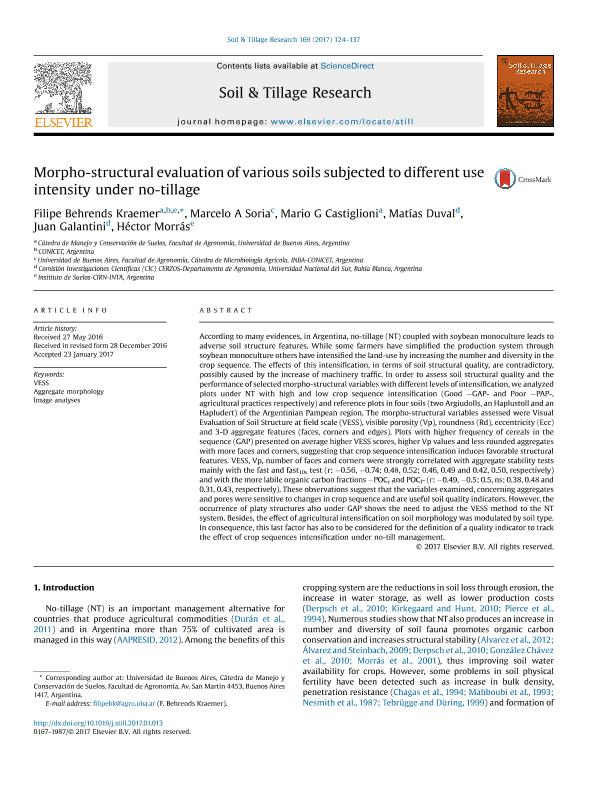Artículo
Morpho-structural evaluation of various soils subjected to different use intensity under no-tillage
Behrends Kraemer, Filipe ; Soria, Marcelo Abel; Castiglioni, Mario Guillermo; Duval, Matias Ezequiel
; Soria, Marcelo Abel; Castiglioni, Mario Guillermo; Duval, Matias Ezequiel ; Galantini, Juan; Morrás, Héctor José María
; Galantini, Juan; Morrás, Héctor José María
 ; Soria, Marcelo Abel; Castiglioni, Mario Guillermo; Duval, Matias Ezequiel
; Soria, Marcelo Abel; Castiglioni, Mario Guillermo; Duval, Matias Ezequiel ; Galantini, Juan; Morrás, Héctor José María
; Galantini, Juan; Morrás, Héctor José María
Fecha de publicación:
06/2017
Editorial:
Elsevier Science
Revista:
Soil & Tillage Research
ISSN:
0167-1987
Idioma:
Inglés
Tipo de recurso:
Artículo publicado
Clasificación temática:
Resumen
According to many evidences, in Argentina, no-tillage (NT) coupled with soybean monoculture leads to adverse soil structure features. While some farmers have simplified the production system through soybean monoculture others have intensified the land-use by increasing the number and diversity in the crop sequence. The effects of this intensification, in terms of soil structural quality, are contradictory, possibly caused by the increase of machinery traffic. In order to assess soil structural quality and the performance of selected morpho-structural variables with different levels of intensification, we analyzed plots under NT with high and low crop sequence intensification (Good −GAP- and Poor −PAP-, agricultural practices respectively) and reference plots in four soils (two Argiudolls, an Haplustoll and an Hapludert) of the Argentinian Pampean region. The morpho-structural variables assessed were Visual Evaluation of Soil Structure at field scale (VESS), visible porosity (Vp), roundness (Rd), eccentricity (Ecc) and 3-D aggregate features (faces, corners and edges). Plots with higher frequency of cereals in the sequence (GAP) presented on average higher VESS scores, higher Vp values and less rounded aggregates with more faces and corners, suggesting that crop sequence intensification induces favorable structural features. VESS, Vp, number of faces and corners were strongly correlated with aggregate stability tests mainly with the fast and fast10s test (r: −0.56, −0.74; 0.48, 0.52; 0.46, 0.49 and 0.42, 0.50, respectively) and with the more labile organic carbon fractions −POCc and POCf- (r: −0.49, −0.5; 0.5, ns; 0.38, 0.48 and 0.31, 0.43, respectively). These observations suggest that the variables examined, concerning aggregates and pores were sensitive to changes in crop sequence and are useful soil quality indicators. However, the occurrence of platy structures also under GAP shows the need to adjust the VESS method to the NT system. Besides, the effect of agricultural intensification on soil morphology was modulated by soil type. In consequence, this last factor has also to be considered for the definition of a quality indicator to track the effect of crop sequences intensification under no-till management.
Palabras clave:
AGGREGATE MORPHOLOGY
,
IMAGE ANALYSES
,
VESS
Archivos asociados
Licencia
Identificadores
Colecciones
Articulos(CERZOS)
Articulos de CENTRO REC.NAT.RENOVABLES DE ZONA SEMIARIDA(I)
Articulos de CENTRO REC.NAT.RENOVABLES DE ZONA SEMIARIDA(I)
Articulos(SEDE CENTRAL)
Articulos de SEDE CENTRAL
Articulos de SEDE CENTRAL
Citación
Behrends Kraemer, Filipe; Soria, Marcelo Abel; Castiglioni, Mario Guillermo; Duval, Matias Ezequiel; Galantini, Juan; et al.; Morpho-structural evaluation of various soils subjected to different use intensity under no-tillage; Elsevier Science; Soil & Tillage Research; 169; 6-2017; 124-137
Compartir
Altmétricas



